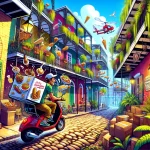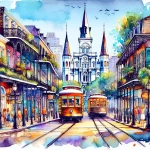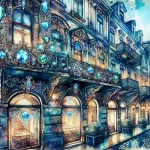New Orleans’ French Quarter enjoys a celebrated reputation for its lively nightlife and distinct beverage traditions, with a storied history spanning centuries. The neighborhood’s iconic drinking establishments play a pivotal role in crafting the city’s identity and attracting visitors worldwide. From classic cocktails to cutting-edge concoctions, these venues offer a taste of New Orleans’ spirit and customs.
In This Article
TL;DR
- The French Quarter flaunts a variety of historic drinkeries, each contributing to the city’s unique beverage culture.
- Many of these establishments have played a crucial role in developing iconic New Orleans cocktails like the Sazerac and the Hurricane.
- French Quarter drinkeries serve as significant cultural hubs, drawing both locals and tourists, and substantially contributing to the local economy.
Historical Context of Drinkeries in the French Quarter
The origins of New Orleans’ drinking culture can be traced back to the city’s early days as a French colony in the 18th century. As the city transitioned between French, Spanish, and American rule, its beverage scene evolved, incorporating influences from various cultures.
During the 19th century, the French Quarter became a hub for drinking establishments, with many bars and pubs catering to the diverse population of the city. The advent of cocktails in the mid-1800s further solidified New Orleans’ reputation as a drinking destination, with local bartenders creating now-iconic drinks like the Sazerac and the Ramos Gin Fizz.
Prohibition in the early 20th century presented challenges for French Quarter drinkeries, but many continued to operate as speakeasies. After the repeal of Prohibition, these establishments experienced a resurgence, with many historic bars and pubs still thriving today.
Iconic French Quarter Drinkeries
The French Quarter is home to numerous longstanding drinkeries, each with its own unique history and specialty drinks. Some notable examples include:
The Sazerac Bar at The Roosevelt Hotel
Named after the iconic New Orleans cocktail, this elegant bar is known for its expertly crafted Sazeracs and Ramos Gin Fizzes.
Pat O’Brien’s
Established in 1933, Pat O’Brien’s is famous for creating the Hurricane cocktail, a sweet and potent rum-based drink that has become synonymous with New Orleans.
Lafitte’s Blacksmith Shop
Dating back to the 1700s, this bar is considered one of the oldest in the United States and offers a unique atmosphere with its candlelit interior and historic architecture.
These drinkeries, along with many others in the French Quarter, contribute significantly to the local economy and tourism industry, attracting visitors eager to experience a taste of New Orleans history and culture.
Architectural and Aesthetic Significance
French Quarter drinkeries are often housed in historic buildings that showcase the neighborhood’s distinctive architectural style, characterized by wrought-iron balconies, colorful facades, and intimate courtyards. The decor and ambiance of these establishments play a crucial role in enhancing the drinking experience, transporting patrons to a different era and immersing them in the rich history of the city.
Many of these historic drinkery buildings have undergone preservation efforts to maintain their original character and charm, ensuring that future generations can continue to enjoy these cultural landmarks.
Cultural Impact and Traditions
French Quarter drinkeries serve as important cultural hubs, hosting a variety of events and performances that showcase local talent and traditions. During Mardi Gras and other festivals, these establishments become gathering places for locals and visitors alike, offering a front-row seat to the city’s vibrant celebrations.
Live music is a staple at many French Quarter drinkeries, with jazz, blues, and other genres performed by local artists. These performances add to the unique atmosphere and cultural richness of the neighborhood.
Beverage Innovations and Signature Drinks
The French Quarter is known for its innovative cocktail scene, with many iconic drinks originating from the neighborhood’s drinkeries. The Sazerac, often considered the world’s first cocktail, was created in New Orleans in the mid-1800s and continues to be a staple at bars throughout the city.
Other notable cocktails with roots in the French Quarter include the Hurricane, the Ramos Gin Fizz, and the Vieux Carré. These drinks often incorporate local ingredients and reflect the city’s cultural influences, such as the use of Caribbean rums and French liqueurs.
Many French Quarter drinkeries employ talented mixologists who continue to push the boundaries of cocktail creation, ensuring that the neighborhood remains at the forefront of the beverage industry.
Best Practices for Visiting French Quarter Drinkeries
To fully experience the range of what French Quarter drinkeries have to offer, visitors should consider the following tips:
1. Timing: Visit during off-peak hours to avoid crowds and ensure a more intimate experience. Weekdays and early evenings tend to be less busy.
2. Exploration: Don’t limit yourself to just one drinkery. Explore the variety of establishments throughout the French Quarter to appreciate the diverse atmospheres and specialty drinks.
3. Etiquette: Be mindful of local customs and etiquette. In New Orleans, it’s common to strike up conversations with fellow patrons and bartenders, creating a friendly and welcoming environment.
Economic and Social Contributions
French Quarter drinkeries play a vital role in the local economy, providing employment opportunities for bartenders, musicians, and other service industry professionals. These establishments also support local suppliers, such as farmers, distillers, and brewers, by featuring their products on drink menus.
Beyond their economic impact, French Quarter drinkeries contribute to the global promotion of New Orleans culture. As visitors from around the world experience the unique atmosphere and beverages offered by these establishments, they help spread the city’s reputation as a top destination for food, drink, and entertainment.
Future Trends and Sustainability Efforts
As the beverage industry evolves, French Quarter drinkeries are adapting to changing consumer preferences and embracing sustainable practices. Many establishments are incorporating locally sourced ingredients, reducing waste, and implementing eco-friendly initiatives to minimize their environmental impact.
Looking ahead, the future of French Quarter drinkeries is likely to involve a balance between preserving the neighborhood’s rich history and traditions while also innovating to meet the demands of modern consumers. By embracing new technologies, experimenting with creative cocktail recipes, and fostering a sense of community, these establishments will continue to thrive as essential components of New Orleans’ cultural landscape.
French Quarter drinkeries offer a unique and immersive experience that combines history, culture, and innovation. By exploring these iconic establishments and savoring their signature drinks, visitors can gain a deeper appreciation for New Orleans’ vibrant spirit and the enduring legacy of its beverage culture.






